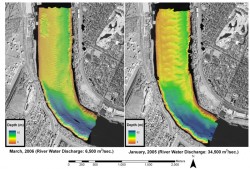Coastal Oceanography: Mead Allison studies areas where large rivers such as the Mississippi discharge into the oceans to better understand ancient delta systems and to reconstruct paleoclimate
November 1, 2007

Mead Allison joined the Institute for Geophysics as a senior research scientist in August 2007. Allison’s research focuses on coastal geological oceanography, including both the modern and paleo environments.
“Most of my work is around the transition where large rivers impact the ocean, the river-dominated continental margin,” Allison said. “These are areas where there are the largest and most rapid accumulations of continentally derived sediments. This is interesting because you have a way to look at modern systems of sedimentary strata formation that can inform us about ancient fluviodeltaic and marine analogs.”
These areas are potentially extremely valuable paleoclimate records as well. They are challenging because they are so dynamic in location and how they are shaped by marine processes, but they could provide a higher resolution record compared to locations farther offshore. Allison’s recent research has focused on the Mississippi Delta region.

“You have this thick, rapidly accumulating sediment adjacent to rivers that provides a high-resolution climate record that includes both organic and inorganic materials,” Allison said. “The nice thing is, compared to tree rings or ice cores, this record is specific to conditions on the adjacent continent. If you look at the Mississippi, you are studying two-thirds of the country. It’s less sensitive to local climatic changes and more integrative of factors that are continental in scale.”
The record from the historical period in the Mississippi has revealed surprisingly detailed information, including the effects of dam construction, institution of soil conservation, clearance for agriculture, and other human activities.
Prior to joining the Institute, Allison was a professor of Earth and Environmental Studies at Tulane University. He earned his Ph.D. from the State University of New York, Stony Brook.
For more information about the Jackson School contact J.B. Bird at jbird@jsg.utexas.edu, 512-232-9623.
